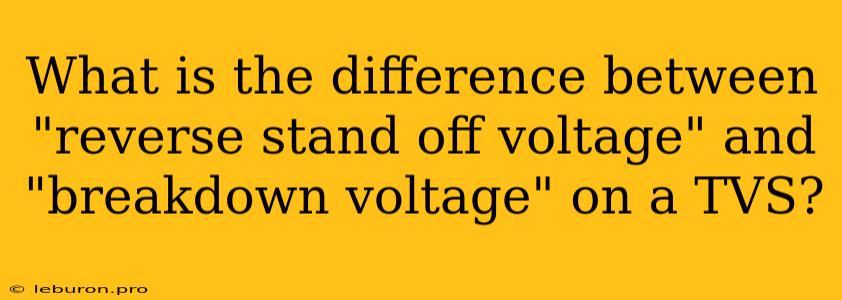Transient voltage suppressors (TVSs) are essential components in electronic circuits designed to protect sensitive devices from damaging voltage transients. Understanding the key parameters of TVSs, such as reverse standoff voltage and breakdown voltage, is crucial for selecting the appropriate device for a particular application. This article delves into the differences between these two crucial parameters, providing a comprehensive understanding of their significance in TVS functionality.
Reverse Standoff Voltage (V<sub>R</sub>)
Reverse standoff voltage is a crucial parameter that represents the maximum voltage a TVS can withstand without conducting. It essentially defines the voltage level at which the TVS remains in its "off" state, acting as an open circuit, effectively blocking the flow of current. This parameter is also known as the non-conducting voltage or clamping voltage and is crucial for determining the operating voltage range of a circuit.
For instance:
- If a TVS has a reverse standoff voltage of 10V, it will not conduct until the voltage across it exceeds 10V.
Factors influencing reverse standoff voltage:
- TVS material: The type of semiconductor material used in the TVS plays a significant role.
- TVS design: The construction and geometry of the TVS impact its standoff voltage.
- Operating temperature: The reverse standoff voltage can vary with temperature.
Breakdown Voltage (V<sub>BR</sub>)
Breakdown voltage represents the threshold voltage at which the TVS begins to conduct, effectively clamping the transient voltage to a safe level. This voltage is typically slightly higher than the reverse standoff voltage, as it signifies the point where the TVS transitions from its non-conducting state to its conducting state. Once the breakdown voltage is reached, the TVS exhibits a rapid decrease in resistance, allowing it to divert the transient current away from the protected device.
Illustrative example:
- If a TVS has a breakdown voltage of 12V, it will start conducting when the voltage across it surpasses 12V, thus limiting the voltage experienced by the protected device.
Note: The breakdown voltage is not a fixed value and can vary depending on the TVS's construction, operating temperature, and the magnitude of the transient current.
Relationship between Reverse Standoff Voltage and Breakdown Voltage
The reverse standoff voltage and breakdown voltage are closely related parameters. The breakdown voltage is usually slightly higher than the reverse standoff voltage. This slight difference is referred to as the breakdown margin and can vary from a few volts to tens of volts depending on the TVS type and design.
The breakdown margin is crucial for ensuring that the TVS effectively clamps the transient voltage without premature conduction.
A larger breakdown margin allows the TVS to handle a higher transient voltage before conducting, providing greater protection for the circuit. However, a larger breakdown margin may lead to a higher clamping voltage, which could potentially affect the performance of the protected device.
Choosing the Right TVS
Selecting the appropriate TVS is crucial for effective transient voltage protection. The reverse standoff voltage and breakdown voltage are key parameters to consider:
- Reverse standoff voltage (V<sub>R</sub>): This voltage must be below the operating voltage of the circuit to prevent the TVS from conducting under normal conditions.
- Breakdown voltage (V<sub>BR</sub>): This voltage should be high enough to effectively clamp transient voltages but low enough to prevent damage to the protected device.
For instance:
- If a circuit operates at 5V, a TVS with a reverse standoff voltage of 4.5V and a breakdown voltage of 5.5V would be suitable.
Applications of Reverse Standoff Voltage and Breakdown Voltage
Understanding reverse standoff voltage and breakdown voltage is crucial for various applications, including:
- Electronic circuit protection: TVSs are widely used in electronic circuits to protect sensitive components such as microprocessors, memory chips, and power supplies from damaging voltage transients.
- Power system protection: TVSs are also employed in power systems to protect sensitive equipment from lightning strikes, voltage surges, and other transients.
- Telecommunication systems: TVSs are critical in telecommunication equipment to protect sensitive circuitry from voltage transients caused by electromagnetic interference (EMI) and radio frequency interference (RFI).
Conclusion
Reverse standoff voltage and breakdown voltage are essential parameters in understanding the behavior of transient voltage suppressors (TVSs). Reverse standoff voltage defines the maximum voltage the TVS can withstand without conducting, while breakdown voltage signifies the threshold at which the TVS begins to conduct, clamping the transient voltage. The difference between these two voltages, known as the breakdown margin, plays a vital role in ensuring effective transient voltage protection.
By understanding the relationship between these parameters and considering the specific requirements of an application, designers can select the appropriate TVS for maximum protection of sensitive electronic devices.
